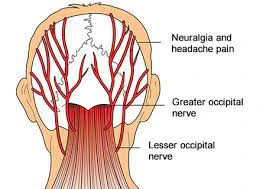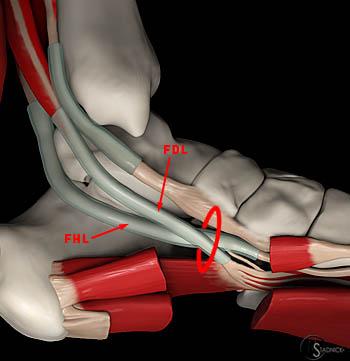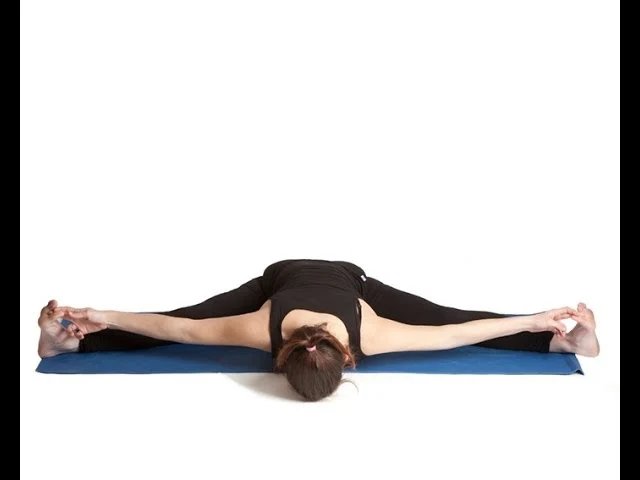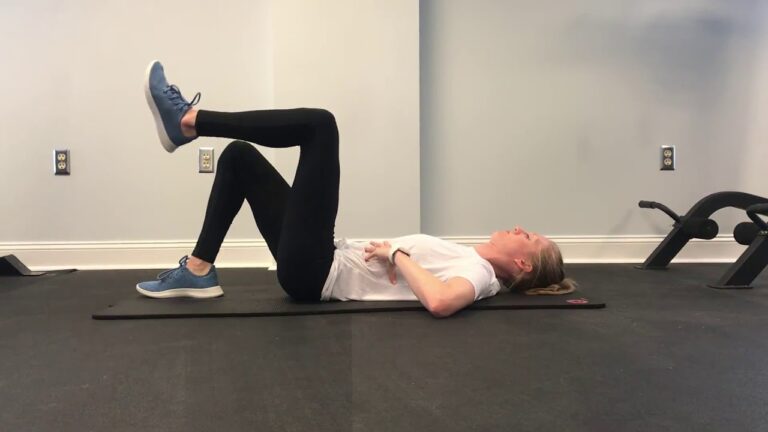Best Exercise for Achilles Tendinitis
Table of Contents
Introduction
There are many exercises, stretches, along with strengthening exercises can help support recovery from Achilles tendinitis. some stretching exercises provide recovery from these tendinitides. exercise provides support, and stability, and reduces pain and inflammation.
Achilles tendinitis defined as is an overuse injury of the Achilles tendon, the band of tissue that connects calf muscles at the back of the lower leg to your heel bone.
Achilles tendinitis mostly occurs in runners who have increased the intensity or duration of their runs suddenly. It is very common in middle-aged people who play sports, such as tennis, volleyball, running, and basketball, only on the weekends or irregularly.
Cases of Achilles tendinitis can be treated at-home care under your healthcare supervision. Self-care strategies are usually important to prevent recurring episodes. More-serious cases of Achilles tendinitis can lead to tendon rupture that may require surgical repair.
What are Achilles tendon injuries?
There are most common injuries of the Achilles tendon
Acute rupture: during this phase seen complete or partial tear occurs when the tendon is fully stretched beyond its capacity.
Achilles tendinopathy: it is a chronic or long-term condition during this phase seen weakness and degeneration of the Achilles due to a series of very small tears (tendinosis).
Causes
a sudden increase in physical activity or less recovery time between activities wearing unsupportive shoes
running on hard or uneven surfaces
tight or weak calf muscles
inadequate warm-up
forceful jumping which give pressure on the tendon, or sudden bursts of running, falling
Achilles tendon ruptures commonly occur in people who play high-energy or high-impact sports on the weekend(play such as basketball, volleyball, tennis, etc).
Exercise for Achilles Tendinitis
Runner’s stretch
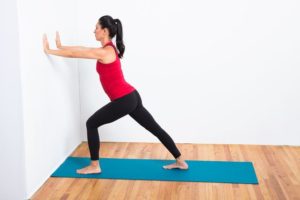
When the Achilles tendon is inflamed, sometimes it becomes tightened and causes discomfort. The runner’s stretch, or calf stretch, will give relief by loosening the tendon.
For this exercise, first, you will need a wall or other support, such as a chair.
Place your both hand on the wall or chair. If you take support of a wall, put your hands at eye level.
place the leg you want to stretch behind you, Keep your back heel on the floor, and point your toes straight ahead.
Bend your other knee toward the wall, keeping your back leg straight which is stretch the calf.
Lean toward the wall until you feel a gentle or mild stretch in your calf and avoid overstretching the calf.
Hold this position for 30 seconds. perform 3 reps daily.
Toe-to-wall stretch
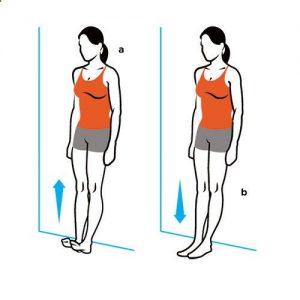
The toe-to-wall stretch exercise can be used if the runner’s stretch exercise makes your shoulders uncomfortable. this exercise give less pressure on the upper body. the runner’s stretch exercise helps improve mobility by decreasing stress on the Achilles tendon.
first Stand facing the wall and place your toes up and against the wall. The higher you place your toes, that gives you deeper the stretch.
after that lean forward and keep your heel on the floor. ( it is necessary that your other leg is behind you and your toes forward and your heel on the ground.)
Hold this position for 30 seconds. performed 3 reps daily.
Heel drop
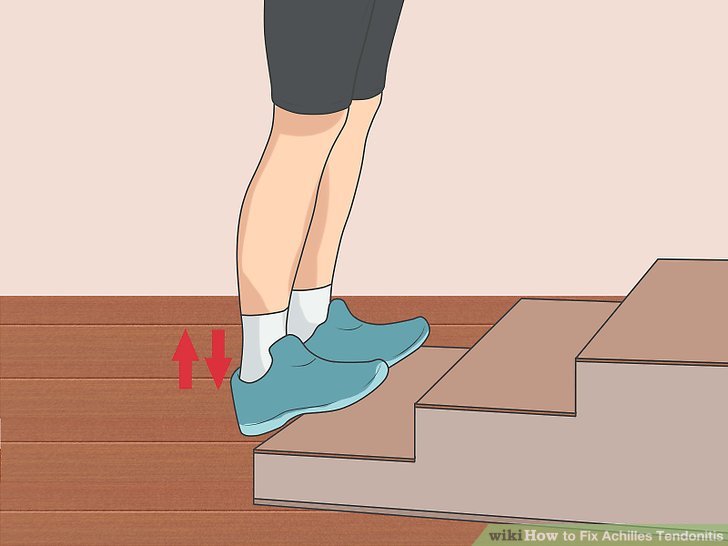
Another Achilles tendon stretch is the heel drop. You can perform it on a staircase or stepladder. If you want to use a stepladder or staircase, make sure it is locked in position.
perform this stretch with the leg that has an Achilles tendon issue or affected leg.
first, you should hold on to the railings of the staircase or ladder.
Put the ball under your foot on the edge of the bottom step.
Let your heel drop down, and provide the relaxed position of the other foot.
Hold this position for 30 seconds. perform 3 repetitions daily.
If you have trouble balancing, perform this exercise under the supervision of a healthcare professional or physiotherapist.
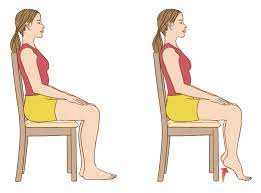
Seated heel raises
During seated heel raises, the muscles in your calf work together to lift your heel. This exercise increases strength and also gives support to the Achilles tendon.
first, you should Sit on a chair or at the edge of a bed. Place your feet shoulder-width apart.
Lift your heels as high as you can pause for 5 seconds, then slowly lower them.
Complete one set of 20 to 35 reps.
Repeat 4- 6 times each day.
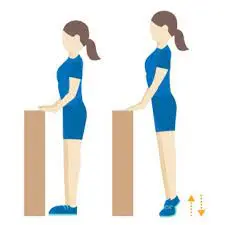
Standing heel raises
If you feel comfortable, you can perform heel raises while standing up or standing position.
you should take a standing position and you should also take support of a chair or edge of the plinth.
Lift your heels and raise onto the balls of your feet. Pause for 5 seconds, then slowly lower your heels.
Complete one set of 15 to 25 reps. Repeat up to 5 or 7 times each day.
Resistance band calf exercise

You should use a resistance band or theraband to maintain the tone of your calf and heel muscles. resistance exercise provide strengthens the calf(gastrocnemius and soleus) muscles by forcing them to work against resistance.
Start with a light resistance band(red in color). As your tendon gets stronger, you can use a thicker band after the use of light resistance(black in color).
Sit on the floor or on a mat and then extend your legs straight out in front of you.
Wrap a resistance band around the foot you want to stretch, bending your knee slightly. Hold the ends of theraband with your hands.
Pull the band through your hand to flex your foot toward you.
Pause this position for 30sec, release, and point your foot away from you.
perform 3 sets of 10 to 15 reps.
Achilles stretching tips
stretch your Achilles tendon regularly. You can continue to stretch your calf even when you don’t feel stiff or sore.
Followed these tips and tricks during stretching:
Take your time: Move slowly or pain-free movement whether you are deepening into a stretch or changing positions. This will decrease the risk of injury and discomfort.
Avoid bouncing: Any type of Quick, sudden movements of your ankle will only worsen Achilles tendon issues. take relaxation between each stretch.
Keep your heel down: During a calf stretch, place your heel on the ground. If you lift your heel, the Achilles tendon doesn’t stretch properly.
Stop if you feel pain: Stretch until you feel minor or mild discomfort, take a pause, then relax. Don’t overstretch or apply force to your muscles. If you feel sharp shooting pain, you should stop stretching immediately.
Stretching is just one process of Achilles tendonitis recovery. Your doctor may also tell you about the importance of rest, applying ice packs, and wearing heel lifts in your shoes.
FAQ
there are self-care strategies that include the following steps, which are known as the R.I.C.E. method. You should avoid exercise for several days or switch to an activity or movement of the leg that doesn’t strain the Achilles tendon or an activity that increased the pain, such as swimming.
Ice.
Compression.
Elevation.(R.I.C.E Method)
Squats can make your leg pain if you have Achilles tendonitis, and lunges can also increase the pain in the leg. but the good news is that you can adapt your squats and lunges exercise to take the strain off your injured Achilles tendon. This adaptation will give you an allowance to continue with your workouts while your tendon recovers.
3 calf strengthening exercises which play a major role to improve and maintaining the strength
Sit on a chair or at the edge of a plinth. Place your feet shoulder-width apart.
Lift your heels as high as possible, pause for 5sec, then slowly lower them.
Complete one set of 15 to 20 reps. Repeat 3 to 5 times each day.
If fast walking is comfortable so it’s okay while these conditions – but if too painful, try using an insert in the heel cushion which provides support (available at most medical stores). slow walking if pain-free so it is okay(use heel cushion while walking).
Avoid exercise while Achilles tendinitis
there are some activities that will aggravate your condition including:
Walking up and down ladders for work.
Walking on uneven ground for long periods.
Walking up and downhill.
Gardening, or other activities involving squatting.
Sporting activities involving jumping, running, and sprinting.


